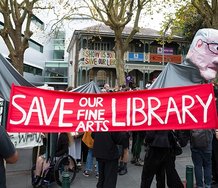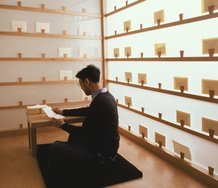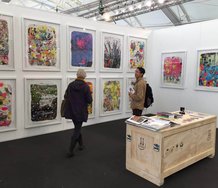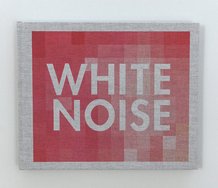Julian McKinnon – 24 October, 2016
Network technology now is a part of us. You can't escape it. Digital interfaces have developed something quite different in terms of visual language - diverging from written or calligraphic pictographic norms. Now I'm not trying to mimic digital imagery, but rather adopt the logic behind the platform, and turn that into a logic of art making. I'm interested in building a vocabulary around informational layering, and the swipe.
EyeContact Interview #2
“...With the loss of horizon also comes the departure of a stable paradigm of orientation, which has situated concepts of subject and object, of time and space, throughout modernity.” Hito Steyerl
Hugo Koha Lindsay is sitting in a Balmoral café, riffing on the influences that shape his artwork. The Auckland based painter has just enjoyed a tremendously successful first showing at Gow Langsford Gallery, yet it’s his enthusiasm for painting that drives the conversation. “I think in many ways my practice is about accumulating painting strategies. Finding positive accidents, and being open to them, is a big part of that. You constantly learn,” he says. Lindsay has had an exceptional 12-14 months, enjoying significant successes in national awards. He featured as a finalist in The National Contemporary Art Award, received a merit award in the Parkin Drawing Prize, won the Kaipara foundation Wallace Arts Trust Award (leading to a residency in Switzerland), and won the Molly Morpeth Canaday Painting and Drawing award. This culminated in the Gow Langsford exhibition, a significant recognition for an artist still in his twenties.
We discuss social media, its pleasures and pitfalls - the abundance of information and imagery and the occasional awkward realisation that you’ve posted something too personal or revealing to a large network of people. Digital technology is a significant shaper of his thinking; he’s interested by how the culture of ‘click and swipe’ shapes cultural norms of perception. “When it first came about it was kind of separate. Network technology now is a part of us. You can’t escape it. Digital interfaces have developed something quite different in terms of visual language - diverging from written or calligraphic pictographic norms. Now I’m not trying to mimic digital imagery, but rather adopt the logic behind the platform, and turn that into a logic of art making. I’m interested in building a vocabulary around informational layering, and the swipe. I’m interested in bringing it back to the haptic, back to gesture, back to the activity of painting.”
Lindsay’s exhibition at Gow Langsford presented a dozen large paintings. The works were sparse in their use of colour, with shades of white, grey and expansive terrains of raw canvas dominating. The occasional shock of bright colour also featured in some of the works. Thick textural lines resting behind subtle monochromatic brushed and sprayed layers revealed themselves at closer inspection. These daubings, created from building adhesives, were used sparingly in most of the works. The constraint in the treatment of individual paintings was countered by the scale and number of artworks on show, with most works registering well over a metre and a half in one of their dimensions. Indexes of folding and scrunching showed in the taut surfaces, revealing an aspect of production process. Lindsay’s visual language, further advanced by areas of masking and cropping, operates in an area of tension between spontaneity and restraint.
Lindsay is happy to discuss the ideas and processes shaping his work, “In many ways I’m diverting distraction into something positive - I can be easily drawn by something visually intriguing, so it’s the incidental, day to day of visual experience that starts to filter in to my paintings.” He draws inspiration from urban spaces: council spray-paint markings on pavements, the ordered jumble of building sites, the palimpsest-like layering of street advertising. He mentions the fold lines in the canvas revealed by light applications of spray paint, and the broad swipes of paint that feature in some of his works. “It offers a way in to the viewer - it gives the painting a kind of transparency. ‘Painting as object’ is a great way of thinking about processes of making, but also a way for viewers to come to an artwork.”
Contemporary art culture, along with global culture more generally, is increasingly being influenced by devices and digital interfaces. Though not only is Internet culture shaping visual language, it’s affecting the way artists produce their work. “I have a background as a representational image maker. Though there were leads from that which have fed in to where my work is at now. I stopped making representational images because I couldn’t anymore. I couldn’t reconcile how to prioritise one image from the billions available. Moving in to abstraction was a way of unlearning, as I had my ways of working that I was quite comfortable with. In a way I’m adding to my technical ‘utility belt’ but undoing old approaches to image making at the same time.”
Part of this shift involved a new working method, involving a different way of looking at the work as it was made. “I became very interested in aerial photography as a type of logic. I took my canvases off the wall and started painting on the floor. I started looking at them as a kind of physical territory-more so than before at least. This change in perspective changes your whole way of making a painting; The materials seem to develop a type of weightlessness. It changes the way you look at things, but also the way you make things, your logic of production shifts and adapts.” Lindsay cites Hito Steyerl’s In Free Fall: A Thought Experiment on Vertical Perspective as a text that influenced him in taking this approach. “Planar shifts also lend themselves to perceptual shifts. The pictorial mechanics are completely different. What does this way of looking at things mean to us? As a perspective it’s alien to the majority of human history. It’s an abstract reality. It’s not really a perspective or a reality that belongs to us,” he says.
For all this, Lindsay is deeply engaged in painting as a historical practice, his influences much broader than contemporary vsual culture. “I find a lot of what’s going on now in contemporary painting is really referencing Modernist painting. You know, non-objective, neo-plasticist ideas are coming back into the discussion. But it’s done with a contemporary flavour, with the influences of digital technology and all that brings,” he says.
Julian McKinnon
 Two Rooms presents a program of residencies and projects
Two Rooms presents a program of residencies and projects Advertising in this column
Advertising in this column



This Discussion has 0 comments.
Comment
Participate
Register to Participate.
Sign in
Sign in to an existing account.